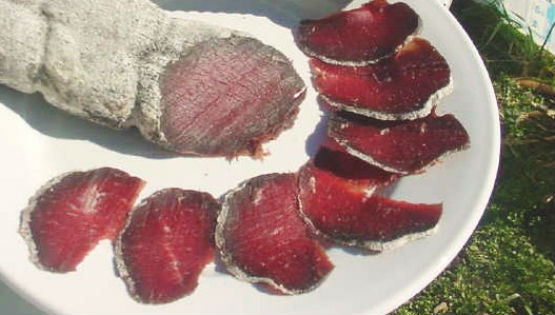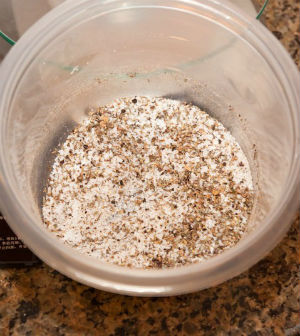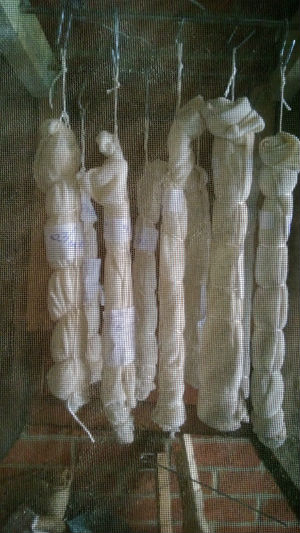This month Dr Simon Lee puts down the rifle and dons the apron as we look at another use for venison, this time turning sirloin fillets into brescaola.

History
Brescaola di cervo, or air dried, cured venison sirloin, has been a southern European hunters staple for hundreds of years. Historically, once the beast was downed and gralloched, out came the offal as a hunter's perk to be eaten immediately. Who hasn't enjoyed a breakfast of fresh kidneys on fried bread after a frozen early start in the middle of winter?
After the skinning and cooling is over the initial stripping down of the carcass can begin, I have the luxury of a sympathetic butcher who, for a fixed price, turns what I bring him into cuts and joints. Without his assistance however, the two long fillets that run along the sides of the vertebra must be carefully removed.
Those lucky enough to hunt larger cervids such as elk or moose will end up with two huge thick fillets the size or a man's arm, but for those of us with access only to the smaller species like Roe will end up with strips perhaps 30cm x 5cms x 10cms, and smaller still for Muntjac. The actual size of fillet is down to size of beast and the care with which you remove the fillets, a confident, scraping action away from the backbone will minimise wastage, this is best learned from an expert.
Butchery
So now you are left with two perfectly removed sirloin strips, resist the temptation to chop them into pieces and chuck them into a hot pan, patience pays off when it comes to cured meats.
With all meat products that are cured or preserved, to reduce the risk of bacterial problems such as e-coli I prefer to deep freeze the venison at -8 degrees Celcius for enough time to kill off any harmful nasties. This does however require careful labeling and dating, more of which will feature later, but it's good practice to avoid the discovery of mysterious bloody lumps being trawled up from the depths of the deep freeze.
Process
 While the deep freeze does it's work, I turn my attention to the all important spice cure, those of you who have been following my previous articles on making jerky will be familiar with the use of 'pink salt' or sodium nitrite to be chemically correct. This pink powder is vital to preserve meat against spoiling but for longer cured recipes like brescaola, we must use sodium nitrate, marketed as Prague Powder No2, chemically it is very similar but cures more slowly before turning into the nitrite salts that preserve and protect the meat.
While the deep freeze does it's work, I turn my attention to the all important spice cure, those of you who have been following my previous articles on making jerky will be familiar with the use of 'pink salt' or sodium nitrite to be chemically correct. This pink powder is vital to preserve meat against spoiling but for longer cured recipes like brescaola, we must use sodium nitrate, marketed as Prague Powder No2, chemically it is very similar but cures more slowly before turning into the nitrite salts that preserve and protect the meat.
After removing the fillets from the deep freeze and whilst we wait for them to slowly thaw out, we can prepare our cure. I prefer to use fresh spices, recently ground, rather than dusty jars of dubious age that have cluttered the cupboards forever.
I like to experiment with the cure, however be advised that for two Roe fillets you will need to create a large mug full of cure [approx 350mls], no hard and fast recipe can be defined but a good guide to starting might include the following: fennel, cumin, black and green peppercorns, juniper berries, coriander seeds, granulated sugar, garlic powder, standard iodized salt, smoked paprike, oregano, cayenne pepper, and the vital Prague Powder No2 (two tablespoons for 350mls of cure is recommended ).
After your choice of cure is decided upon, all spices must be ground up in a mill or more traditionally with a mortar and pestle, I prefer to reduce the ingredients to a slightly gritty consistency, too fine and dusty tends to create an unmanageable paste. It's a good idea to get into good habits here and keep a log of what cure you use, and in what quantities, nothing is as frustrating as developing a really good cure and losing the recipe!
Now you will need to cleanly remove the silverskin on the fillets, this is best done with a sharp knife or cleaver held at an angle and the fillet pulled toward you on a cutting board, after a little practice this will result in an undamaged fillet and a strip of sinew, practice makes perfect. All traces of this silverskin must be removed as the cure must touch all parts of the meat, leaving sinew on will result in uncured areas impairing the finished product.
Next stage is to thoroughly coat the fillets in the spice cure, Personally I like to shake the meat and cure together in a bag using about half of the prepared cure, before sealing them in zip-lock bags or vacuum sealed pouches. These are then labeled and dated and placed in the fridge for seven days and turned every day.
After a week's patient flipping, remove the fillets and drain off all the liquid that has been produced, then coat the fillets in the rest of the cure, seal into a fresh bag or pouch and put them back in the fridge for another week of daily turning. When this second week is over, remove the fillets, rinse all remaining cure off under a cold tap and pat dry with kitchen towels.
 At this stage weigh each fillet, and prepare a label, with date, weight and cure recipe, the dry fillet is then wrapped in clean stockinette and bound with butchers twine with a set of running hitches. To retain the vaguely oblong shape of the fillet resist the temptation to tighten the hitches to render the shape cylindrical, leave that for sausages. The aim is to produce a strip of meat that is uniform along its length. Now weigh the wrapped fillet and remove the tare weight of the cloth and string, making a note on the label.
At this stage weigh each fillet, and prepare a label, with date, weight and cure recipe, the dry fillet is then wrapped in clean stockinette and bound with butchers twine with a set of running hitches. To retain the vaguely oblong shape of the fillet resist the temptation to tighten the hitches to render the shape cylindrical, leave that for sausages. The aim is to produce a strip of meat that is uniform along its length. Now weigh the wrapped fillet and remove the tare weight of the cloth and string, making a note on the label.
The real exercise in patience now begins, in a cool, dry and dark place with some form of protection from flies, hang the fillets up until they have lost 30-35% of their weight. I use a screened mesh box in a garage that maintains a temperature of 15-18 degrees Celcius, a cellar would be equally good but humidity levels need to be kept low.
After the weight reduction is reached, about three weeks with my set up, the brescaola is ready for consumption. After removing the string and stockinette, the fillets will be darker in colour and stiffened but not inflexible, any mould that may have formed on the fillet should be white, this is harmless and actually beneficial, on the other hand, mould colours such as black or green indicate the presence of potentially harmful bacteria and should be ruthlessly discarded, if in doubt, chuck it out.
With good hygiene practices and following the recipe above, you should now have two fillets of delicious venison brescaola, this is best enjoyed thinly sliced and served as charcuterie or drizzled with olive oil and lemon juice on salad, a good indicator of success is a nice pink colour in the centre of the fillet with a deeper brown outer ring, another good sign is the sample plate picked clean with requests for more.
So, if you have some venison fillets, a cure, and some time, space and patience, why not have a go at making your own brescaola di cervo?
If you'd like to read more from Simon then follow this link to an article in which he explains: how-to-make-venison-jerky
Alternatively to read more about some of the benefits of eating venison follow this link: venison



















